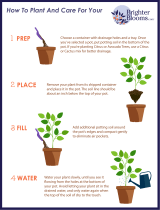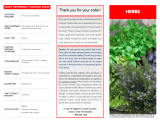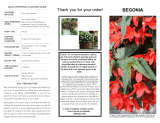Page is loading ...

**IImmaaggee oonn ccoovveerr iiss rreepprreesseennttaattiivvee ooff tthhee ttyyppee ooff ppllaanntt((ss)) iinn tthhiiss ooffffeerr aanndd
nnoott nneecceessssaarriillyy iinnddiiccaatti
ivvee ooff aaccttuuaall ssiizzee oorr ccoolloorr ffoorr tthhee iinncclluuddeedd vvaarriieettyy
.
SSUUCCCCUULLEENNTTSS
Thank yyou ffor yyour oorder!
Succulents stand out in the garden and home
with diverse colors and unusual textures. Ideal for
indoor gardens and water-wise landscapes in
frost-free areas, these drought tolerant beauties
add southwestern flair to any garden. Succulents
thrive in small containers and require little care,
making them an excellent low-maintenance
choice for gardeners of all skill levels.
Caution:
Do nnot aassume aany pplant iis ssafe tto eeat.
Only pparts oof pplants eexpressly ggrown tto bbe eeaten
should bbe ccons
idered eedible. AAs wwith aany pproduct
that iis nnot ffood, ccare sshould bbe ttaken tto mmake
sure tthat ssmall cchild
ren aand ppets ddo nnot iingest
any ppart oof aa pplant tthat iis nnot eexpressly ggrown tto
be eeaten.
Unless specifically stated, this product is
intended for ornamental horticultural use only
and is not intended for consumption or inges-
tion by humans or pets. Most plants are harmless
but some contain toxic substances which can
cause adverse health effects. Furthermore, some
individuals and some animals are sensitive or
allergic to certain plants and precautions should
be taken to limit or avoid physical contact with
particular plants. Some plants have thorns or
spines that can be painful if handled.
In ccase oof iingestion ccontact aa ppoison ccontrol
center iimmediately.
1-8800-2222-11222
Indoors:
Bright light.
Outdoors:
Full sun.
LIGHT/SUN
EXPOSURE
USDA
HARDINESS
ZONES
PLANTING
DISTANCE
IN-GGROUND
Not winter hardy in-ground.
Will thrive from spring to fall in
all zones.
We recommend planting in a
container so you can move the
plants indoors before the first frost.
MATURE
HEIGHT // SSPREAD
6 to 12 inches tall with a similar
spread.
Midsummer.
Excellent as houseplants.
Drought tolerant and easy to grow.
Unique shapes and colors.
BLOOM TTIME
TIME TTO RREACH
MATURITY
FACTS OOF NNOTE
PLANT TTYPE
Tropical.
CONTAINER SSIZE
One plant per 10-inch or larger
container.
QUICK REFERENCE PLANTING GUIDE
At least 12 inches apart.
12 months.

Succulents should be grown in a container and
moved indoors before the first frost. When you
bring your plant indoors for the winter, select a
room with a sunny window.
Water sparingly over the winter. Remove any
unsightly or dead growth as needed to maintain an
attractive appearance, and do not be alarmed if
your plant sheds some of its foliage.
In spring when temperatures begin to rise, move
the plant back outdoors for the summer.
PLANTING INSTRUCTIONS
PLANTING INSTRUCTIONS
Adequate and consistent watering is essential during
your plant's first year in the garden. Once established,
this plant is very drought tolerant and requires little
watering.
Due to variable geographical and environmental
conditions, a specific watering schedule is difficult to
define. However, as a rule of thumb, you should not
allow the soil or the original root ball to completely
dry out. During the first summer, you may need to
water as often as every few days in periods of
drought and extreme summer heat. To determine if
your plant needs water, dig a few inches into the soil
next to the plant. If the soil is dry 2-3 inches below the
surface, it is time to water.
If you plant in a container, allow the top half of soil
to dry out moderately between waterings. Water
thoroughly until the soil is well-saturated and excess
water drains out of the drainage holes at the bottom
of the container. Never allow the plants to sit in a
saucer of water. Pots may be kept in saucers after
any excess water has drained from the pot.
FFEEEEDDIINNGG
Feed your plants once every 2-3 weeks during the
growing season with a water soluble fertilizer
.
Discontinue feeding after September 1st so your
plants can prepare for winter. Resume fertilizing
when new growth appears in the spring.
WWIINNTTEERRIIZZIINNGG
CONTINUING CARE (Continued)
A
Always plant succulents in well-drained soil or in containers
with drainage holes. We strongly recommend planting in a
container in order to properly protect your plant from
winter damage. Use the following instructions as a guide
for container planting.
Important:
Thoroughly hydrate the plant by submersing
the root zone in a container of water for 10 minutes while
you prepare for planting.
B
Water well and, if necessary, adjust the plant so it is
upright and add additional soil if needed, Check to
be sure the plant is not planted too deeply. If it is,
raise the plant carefully and re-firm the soil.
C
Once the plant is properly positioned in the pot,
begin filling the pot with soil. Work the soil around
the root ball with your hands, firming the soil
around the plant with your fingers. When the hole is
filled, tamp the soil to remove any air pockets.
Fill the container with soil to within 4 inches of the
top. Remove the pot and prepare the root ball for
planting by gently disturbing the surface roots with
your fingers, fork, or gardening tool and pruning
any damaged roots. Dig a hole in the soil to insert
the lower part of the root ball.
Remove any dead, damaged or unsightly growth at
any time to maintain an attractive appearance. Clip
off spent flower stalks once the blossoms have
faded.
PPRRUUNNIINNGG
WWAATTEERRIINNGG
CONTINUING CARE
OUT OF THE BOX
Your plants have been shipped to you in pots. We urge
you to remove them from the shipping box and plant
them as soon as possible. Should planting be delayed due
to weather or other unforeseen circumstances, roll the
plastic bag down around each plant and place them near
a bright window or other sunny location. Keep them well-
watered in their pots until permanently planted. Once
planted, they begin setting roots and, as the weather
warms, begin showing new growth. Please plant as soon
as possible, provide reasonable care and be patient.
SUCCULENTS
The foliage on potted plants may appear slightly wilted or
yellow upon arrival. This is due to the stress of shipping
and is usually nothing to worry about. Water the plant
thoroughly, place it in a shady location and remove any
foliage that does not recover.
/





